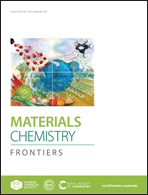Molecular-level design of excellent reversible thermochromic polydiacetylene materials with the simultaneous enhancement of multiple performances†
Abstract
Recently, colorimetrically reversible materials have been paid significant attention not only to gain a better understanding of the fundamentals of their chromism but also to create ways to overcome the limitations associated with their colorimetrically irreversible counterparts. Generally, the properties of polydiacetylene (PDA)-based supramolecular materials strongly depend on their molecular packing structures, and the blue-colored PDAs undergo a color change to red when they are exposed to various stimuli. To achieve the reversible structural transition, we rationally designed a new L-Glu (L-glutamic acid)-derivatized diacetylene (DA–Glu) monomer to enhance the hydrogen-bonding interactions. Then, we developed a method to fabricate PDA–Glu/PDMS films, which could be readily obtained by mixing the PDMS precursor with the DA–Glu monomers, curing at an optimal temperature, and subjecting to UV irradiation. The prepared PDA–Glu/PDMS film showed excellent reversible thermochromism property when the temperature changed from 20 to 80 °C. Deep investigations revealed that the reversible thermochromism behavior could be attributed to the enhanced hydrogen-bonding interactions and the formation of a network structure in the PDA–Glu/PDMS film, which provided sufficient recovery force and free space for the PDA–Glu structures to reversibly vary with temperature. Further studies demonstrated that the formation of unique network structures did not only endow the PDA–Glu/PDMS film with excellent reversible thermochromism property, but also with good thermal stability and mechanical property. We believe that combining the waterproof property and other advanced properties of PDMS, the prepared PDA–Glu/PDMS films would present very promising applications in many fields. Our research opens a new way to improve the performance of materials and bestow them with novel properties by modifying the monomers at the molecular level.



 Please wait while we load your content...
Please wait while we load your content...